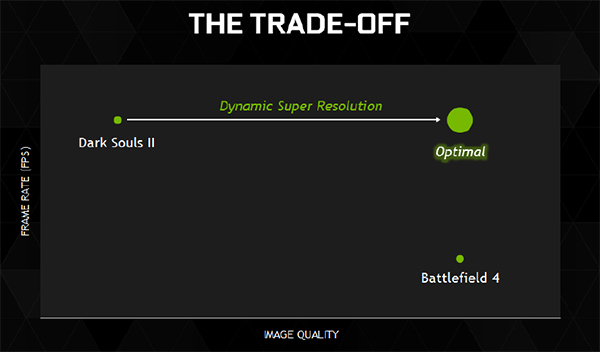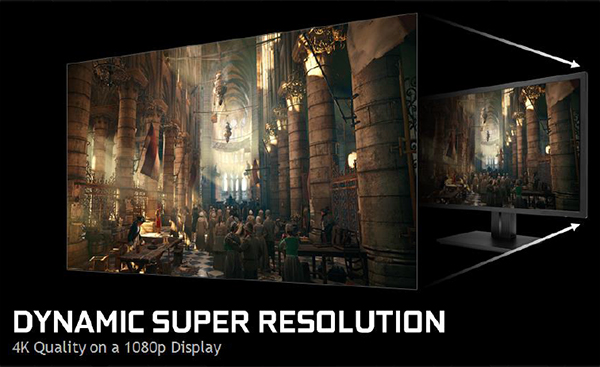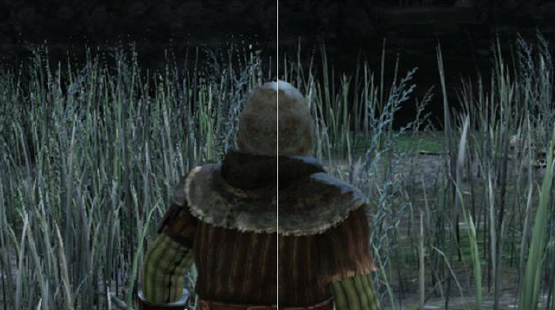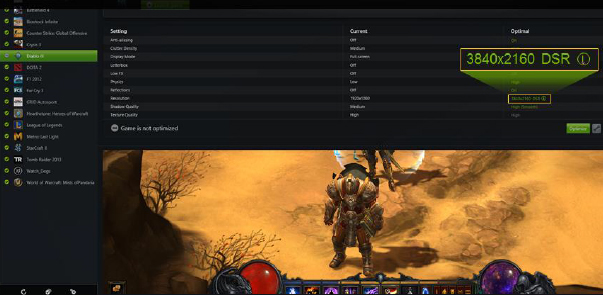Index
- Nvidia GTX 980 reviewed
- The GM204 GPU
- VXGI, dynamic global illumination technique
- MFAA, multi-frame sampled anti-aliasing
- DSR, dynamic super resolution
- A closer look at GTX 980
- Testbed
- 3DMark
- Sleeping Dogs
- Crysis 3
- Thief
- Battlefield 4
- BioShock
- Tomb Raider
- Far Cry 3
- Unigine Heaven
- Thermals and Noise
- Power Consumption
- Conclusion
- All Pages
Dynamic Super Resolution (DSR) provides an easy way for gamers to improve the image quality in less demanding games. DSR is bringing the crispness of higher resolutions to gamers’ existing displays. We like the idea since a lot of people enjoy undemanding games and DSR can give them a splash of eye candy.
The basic idea revolves around using unharnessed GPU power to render the scene at a higher resolution, then scaling the image down to the native resolution. While it may sound like a pointless waste, a similar approach has been used in professional off-line graphics for years.
For example, a gamer with an 1080p display could use DSR to have the GPU render an image at a substantially higher resolution, which is then scaled back to 1080p, while still retaining more detail than a standard 1080p rendering. It is not 4K resolution quality, but it simply adds a bit more detail to lower resolution games.


The differences are most evident where you would expect them to be – on high contrast areas and thin objects such as hair, grass, wires and foliage. Basically stuff that looks terrible without antialiasing.
The next image shows the difference on a 1080p scene with and without DSR.

Dynamic Super Resolution is similar to the downsampling, which is used by enthusiasts today. However, many games were not designed with downsampling in mind, leading to artifacts in the final rendered image.
To address this issue, DSR uses a 13-tap Gaussian filter during the conversion to display resolution. This high-quality filter reduces or eliminates the aliasing artifacts experienced with downsampling, which relies on a simpler box filter (which is also computationally less demanding).
GeForce Experience uses the default 33% smoothness level for the Gaussian filter. Alternatively, you can use the DSR Smoothness setting in the driver’s control panel to adjust the smoothness level. Simply open the control panel and navigate to Manage 3D Settings and choose DSR Factors to select your screen resolution (settings ranging from 1.2x-4.0x native resolution in the current implementation) and use the DSR Smoothness setting to adjust the Gaussian filter, then launch your favorite game. You should be able to find the new DSR resolution inside the graphics menu settings of the newly launched game.
Another issue with conventional downsampling is ease of use. Because it isn’t a native solution, downsampling requires users to trick the GPU into thinking it’s connected to a higher resolution display than it actually is. In order to do this, users have to create custom screen resolutions and often have to adjust various low-level display parameters in order for downsampling to work.
In comparison, Dynamic Super Resolution can be found inside GeForce Experience, where Nvidia provided convenient and easy to use controls for DSR with optimized game settings. The user simply needs to click the “Optimize” button and that’s it.

DSR can be used with GTX 980 / 970 cards but, you need a screen capture card or FCAT in order to make screenshots with DSR enabled. Otherwise you will simply get higher resolution screenshots, which do not illustrate what you are seeing on your lower resolution screen screen.



